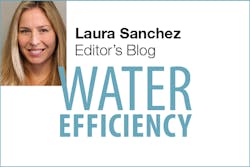Many agricultural areas of the American West are reliant on groundwater withdrawals—and even more so in the face of drought. But many aquifers have become depleted or overdrafted over the years. And as temperatures rise with climate change and as droughts become more extreme, overdrafts are likely to increase. To help ensure sustainable water supplies, farmers today are attempting to restore water sources beneath agricultural fields through a practice called on-farm groundwater recharge.
For decades humans have extracted water from aquifers at far greater rates than precipitation has been able to replenish them, creating a massive deficit, explains Dr. Helen Dahlke, Associate Professor of Integrated Hydrologic Sciences in the Department of Land, Air, and Water Resources at the University of California, Davis. To put this deficit in perspective, Dahlke states that, “During the period 1960–2016, we have extracted about 80 million acre-feet (MAF) beyond what is naturally replenished from rainfall. 80 MAF is 700 years of the annual water use for the District of Columbia. Another way to think about it is that the entire volume of Lake Tahoe is 120 MAF, a lake that is over 500 yards deep.”
In order to replenish groundwater sources, water must be slowed and allowed to permeate the soil surface. “On-farm groundwater recharge is putting the beaver back in the watershed,” explains Jeff Barry, principal hydrogeologist at GSI Water Solutions, of slowing water down on its journey across land. “If you look at the history of our occupancy of land, in order to create viable agricultural spaces, we channelized farmland and took measures to promote runoff. Without pooling, ponds, and beaver dams, aquifers aren’t naturally recharged. Therefore, the need exists to slow water down as it flows.”
There are a number of different techniques for on-farm groundwater recharge. Barry is a proponent of placing recharge locations at higher positions in the water system than low-lying basins. A method that Dahlke is currently researching involves flooding agricultural fields. Dahlke and her team have conducted trials with on-farm groundwater recharge, flooding sites planted to alfalfa and almonds to evaluate impacts of excess water on crops.
The team’s research determined that when groundwater recharge is performed on soils that have high infiltration rates, there seems to be little harm to either the alfalfa or almond crops, but these flooding events must be temporary and applied with pulse irrigation to allow air to reenter the root system.
Hydrogeologists agree that there are a number of factors to consider when selecting a site for on-farm recharge, including geography, soil type, proximity to aquifers, and crop suitability, among others. “Not all areas are connected to deeper aquifers. Where you do this, as well as the specific geology of that area, is critically important,” explains Barry. Today online tools such as the Soil Agricultural Groundwater Banking Index (SAGBI) and the Groundwater Recharge Assessment Tool (GRAT) are available to support decision-making.
Since the passage of the Sustainable Groundwater Management Act (SGMA), a three-bill policy that requires increased reporting and sustainable basin management, the agricultural community has become more invested in the protection of their water resources. Don Cameron, vice president and general manager of Terranova Ranch and an early adopter of on-farm groundwater recharge, recently told Water Deeply that the 2014 policy had a catalyzing effect.
“All of a sudden the growers started to understand what SGMA meant at the grower level, and what that meant was that in the future they may not be able to farm all of their land,” Cameron said. “They’re definitely not going to be able to pump all of the water that they’ve been pumping in the past, and to mitigate that, they’re going to have to do groundwater recharge.”
What are your impressions? Do you think that on-farm groundwater recharge offers a practical solution for agricultural water management?
